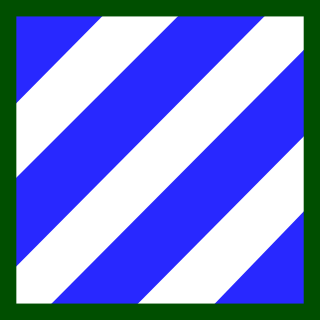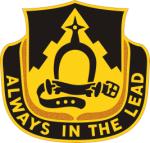
The 11th Armored Cavalry Regiment is a unit of the United States Army garrisoned at the Fort Irwin National Training Center in California. The regiment has served in the Philippine–American War, the Pancho Villa Expedition, World War II, the Vietnam War, Gulf War and Iraq War. The 11th ACR serves as the opposing force (OPFOR) for the Army and Marine task forces, and foreign military forces that train at Fort Irwin.

The 1st Cavalry Regiment is a United States Army regiment that has its antecedents in the early 19th century in the formation of the United States Regiment of Dragoons. To this day, the unit's special designation is "First Regiment of Dragoons". While they were the First Regiment of Dragoons, another unit designated the 1st Cavalry Regiment was formed in 1855 and in 1861 was re-designated the 4th Cavalry Regiment. The First Dragoons became the 1st Cavalry Regiment, since they were the oldest mounted regiment.

The Pennsylvania Army National Guard, abbreviated PAARNG, is part of the United States Army National Guard and is based in the U.S. Commonwealth of Pennsylvania. Together with the Pennsylvania Air National Guard, it is directed by the Pennsylvania Department of Military and Veterans Affairs. The PAARNG maintains 124 armories and is present in 87 communities across the Commonwealth.

The 112th Infantry Regiment, also known as the Sixteenth Pennsylvania, is a unit in the Pennsylvania National Guard which can trace its lineage back to before the American Civil War.

The Washington Army National Guard is a component of the United States Army and the Washington National Guard based in Washington. The history of the Washington Army National Guard dates back to 1854 with formation of the Washington Territorial Militia. The command is headquartered at Camp Murray in Pierce County. It consists of 6,200 soldiers in two brigades and various smaller units located throughout the state.

The 205th Infantry Brigade, was first formed as part of the United States Army Reserve's 103rd Division. It was active from 1921 to 1942 and then from 1963 through 1994, and then reformed in 2006.

The 108th Cavalry Regiment is a cavalry regiment of the Georgia and Louisiana Army National Guards of the United States Army.

The 48th Infantry Brigade Combat Team is a modular infantry brigade of the Georgia Army National Guard. One of the oldest units in U.S. Army history, the lineage of the 48th Infantry Brigade can be traced back to 1825. It is one of few units in the US military that also saw service as a unit of the Confederate States of America during the American Civil War. Today, the 48th IBCT is part of the U.S. Army's "Associated Units" program where it is aligned under the 3rd Infantry Division, a combined arms combat maneuver unit of the Regular Army.

The 163rd Infantry Regiment is a regiment of the Montana National Guard. It went overseas with the 41st Infantry Division in World War II.

The 107th Cavalry Regiment, Ohio Army National Guard, is a parent regiment under the U.S. Army Regimental System, with headquarters at Hamilton, Ohio. It currently consists of the 2nd Squadron, 107th Cavalry Regiment, part of the 37th Infantry Brigade Combat Team (BUCKEYE), Ohio National Guard located throughout southwest Ohio.
The 110th Cavalry Regiment was a regiment in the United States Army National Guard and was part of the Massachusetts Army National Guard.

The 300th Field Artillery Regiment is a Field Artillery regiment of the United States Army.

The 102nd Cavalry Regiment is a cavalry regiment of the United States Army first established in 1921. It has seen service in the Second World War, including in Normandy and at the Battle of the Bulge, in Iraq 2008-2009, in Jordan and Somalia in 2019, plus many exercises and Hurricane Sandy and Hurricane Maria relief. Its tradition of service is carried on today by the 1st Squadron 102nd Cavalry Regiment.

The 2nd Squadron, 107th Cavalry Regiment is a cavalry squadron of the 37th Infantry Brigade Combat Team and the Ohio National Guard located throughout southwest Ohio.
The 203rd Engineer Battalion is a combat engineer battalion of the Missouri Army National Guard.

The 149th Armored Regiment was an armored regiment that was part of the California Army National Guard. Its lineage dates back to a cavalry unit organized in 1895 in Salinas. As Troop C, the unit's first major action occurred when it deployed to help in the aftermath of the 1906 San Francisco Earthquake. In 1916, still as Troop C, the unit served along the Mexico–United States border near Nogales, Arizona to deter further border incursions, due to events surrounding the Pancho Villa Expedition. The following year, Troop C was activated then reorganized and redesignated as Company B, 145th Machine Gun Battalion upon the United States' entry into World War I; as part of the 40th Division, the battalion deployed to France in 1918, and returned to the United States in 1919.

First Squadron, 153rd Cavalry Regiment "Darkhorse" is an element of the Florida Army National Guard, headquartered in Panama City, Florida with units throughout the Panhandle. It was formerly 3rd Battalion, 124th Infantry and officially converted to cavalry on 1 September 2007 when the 53rd Infantry Brigade converted from a "separate brigade" to the brigade combat team structure.

The 303rd Cavalry Regiment is a United States cavalry regiment, currently represented in the Washington Army National Guard by the 1st Squadron, 303rd Cavalry, headquartered at Vancouver, Washington, part of the 96th Troop Command. It incorporates the lineage of the 303rd Cavalry, 303rd Armor, and 803rd Armor Regiments of the Washington Army National Guard.

The 124th Cavalry Regiment is a United States Army cavalry regiment, represented in the Texas Army National Guard by 1st Squadron, 124th Cavalry, part of the 56th Infantry Brigade Combat Team at Waco.
The 127th Field Artillery Regiment was a field artillery regiment of the Kansas Army National Guard that traced its lineage to 1916. The 1st Battalion, the only active unit of the regiment, was inactivated in 2007.





















